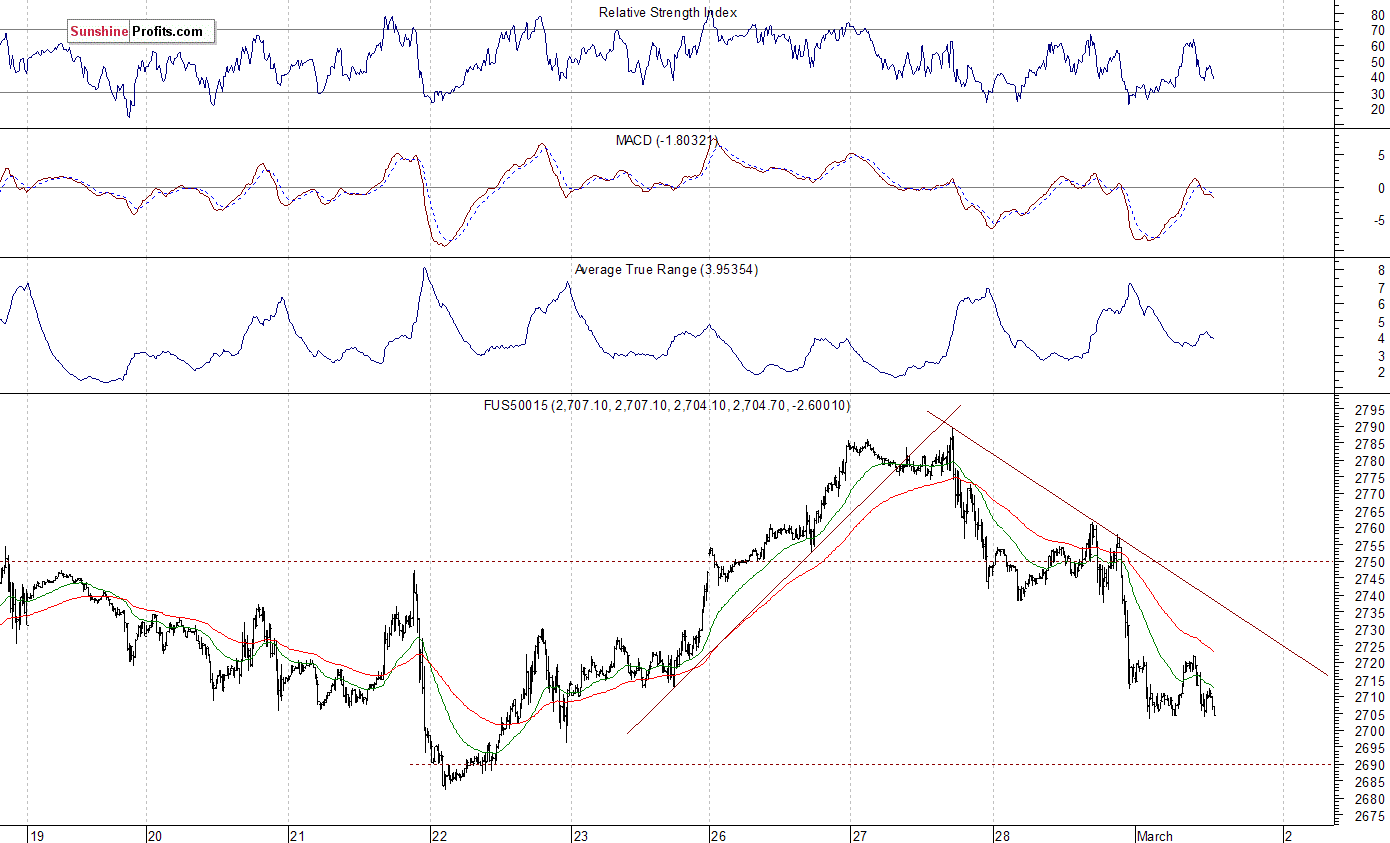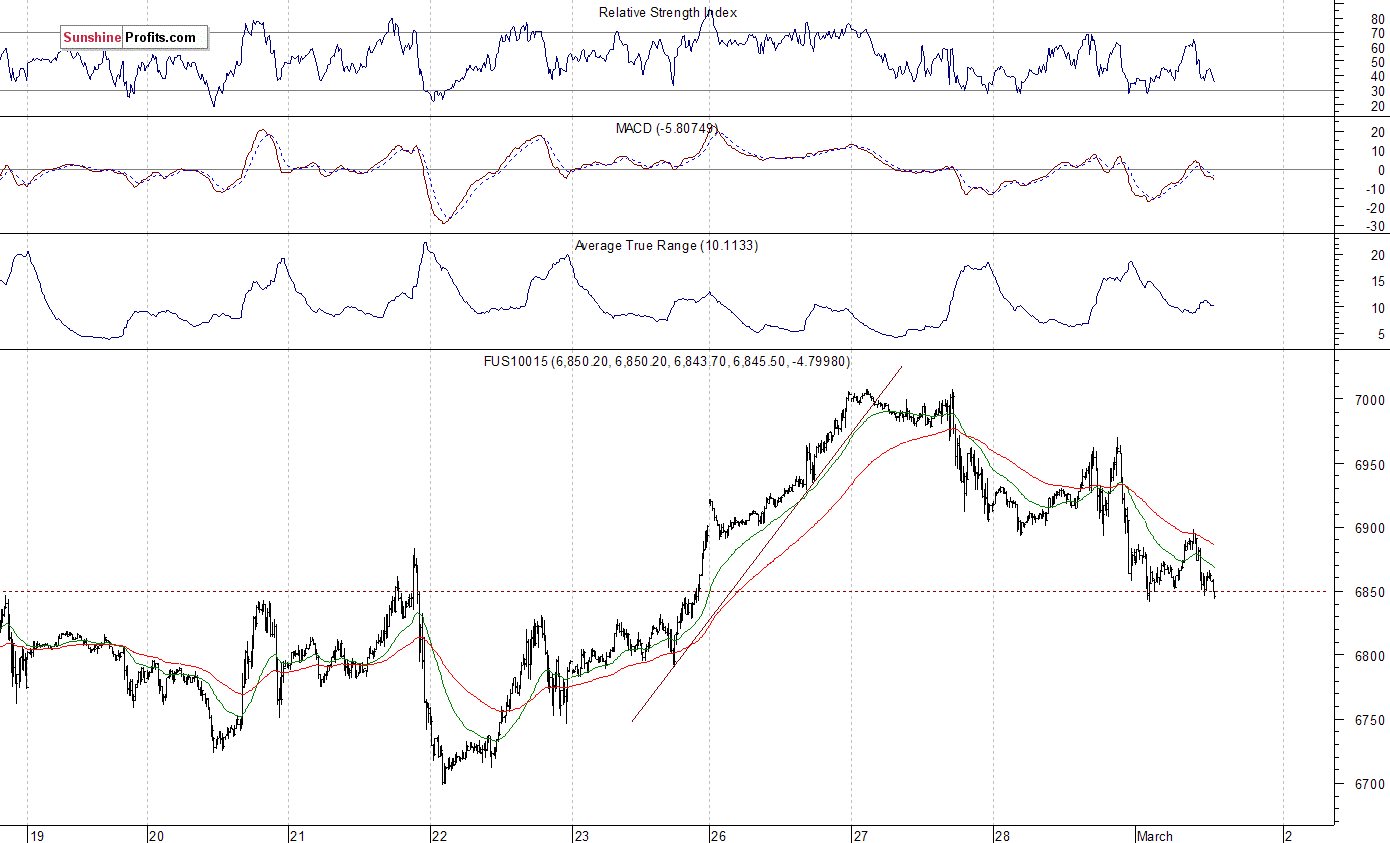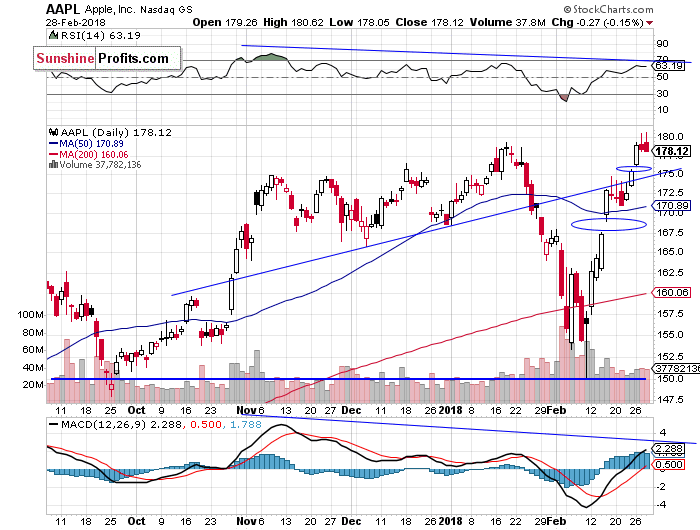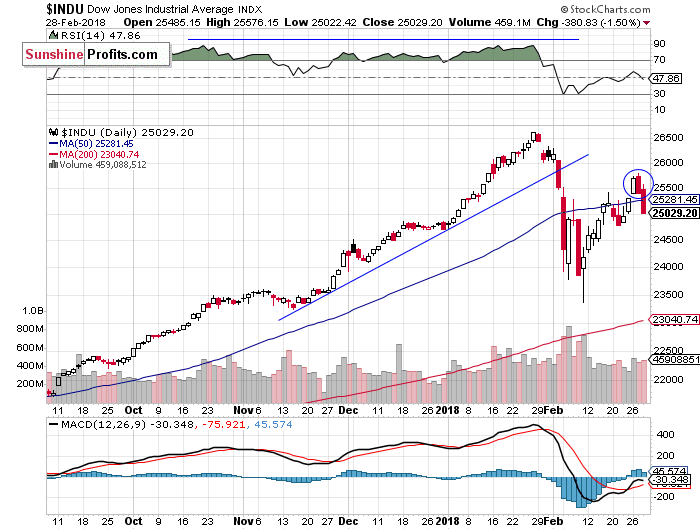
Yesterday's trading session brought the main U.S. stock market indexes 0.8-1.5% down, as investors' sentiment worsened following Tuesday's downward reversal. Stocks broke above their short-term consolidation on Monday, but they failed to continue higher. Consequently, they fell into their last week's consolidation and the S&P 500 index got closer to 2,700 mark again. Stocks are expected to open lower today, but they may retrace some of their two-day-long sell-off. Where is a potential support level?
Stocks extended their Tuesday's move down yesterday, as the main U.S. stock market indexes lost 0.8-1.5% vs. their Tuesday's closing prices. Investors' sentiment worsened and the market got back to its last week's trading range. The S&P 500 index fell closer to 2,700 mark again. It currently trades 5.5% below January 26 record high of 2,872.87. The Dow Jones Industrial Average lost 1.5% yesterday, as it was relatively weaker than the broad stock market gauge. On the other hand, the technology Nasdaq Composite lost 0.8% yesterday. Tech stocks were relatively stronger than the rest.
The nearest important level of resistance of the S&P 500 index is now at around 2,750-2,760 again, marked by local high. The next resistance level remains at 2,790-2,800, marked by short-term local highs. On the other hand, support level is at around 2,700, marked by last week's local lows. If the market continues lower, potential level of support would be at 2,670, marked by previous local highs.
The S&P 500 index reached its record high more than a month ago on January 26. It broke below month-long upward trend line, as it confirmed uptrend's reversal. Then the broad stock market gauge retraced all of its January rally and continued lower. The index extended its downtrend on February 9, as it was almost 12% below the late January record high. We can see that stocks reversed their medium-term upward course following whole retracement of January euphoria rally. Then the market bounced off its almost year-long medium-term upward trend line, and it retraced more than 61.8% of the sell-off within a few days of trading. Is this just an upward correction or uptrend leading to new all-time highs? The market seems to be in the middle of two possible future scenarios. The bearish case leads us to February low or lower after breaking below medium-term upward trend line, and the bullish one means potential double top pattern or breakout above the late January high. However, the most likely scenario may be that stocks go sideways for a while:

Negative Expectations Before the Open
The index futures contracts are trading 0.3-0.4% lower vs. their Wednesday's closing prices right now. The European stock market indexes have lost 0.8-1.1% so far. It means that investors' expectations ahead of the opening of trading session are negative, and stocks may extend their recent downtrend. But will they continue lower? We may see upward correction at some point. Investors will wait for some economic data announcements today: Personal Income, Personal Spending, Initial Claims at 8:30 a.m., ISM Manufacturing PMI number at 10:00 a.m.
The S&P 500 futures contract is within an intraday consolidation, following yesterday's move down. For now, it looks like some flat correction within a short-term downtrend. The nearest important level of support is at around 2,690-2,700. On the other hand, resistance level is at 2,720, and the next level of resistance remains at 2,740-2,760, marked by recent consolidation. The futures contract trades below its short-term downward trend line, as the 15-minute chart shows:

Nasdaq Also Lower
The technology Nasdaq 100 futures contract is trading within a similar intraday consolidation following yesterday's move down. The market fell below 6,900 mark and continued lower. It sold off from its Tuesday's highs above the level of 7,000. Tech stocks have retraced almost all of their severe late January - early February move down, but they currently trade just above last week's consolidation. Will they break lower? The nearest important level of support is at around 6,850. Potential support level is also at 6,750-6,800. On the other hand, resistance level is at 6,900. The Nasdaq futures contract trades along its last week's consolidation, as we can see on the 15-minute chart:

Apple and Amazon Made New Record Highs Yesterday
Let's take a look at Apple, Inc. stock (AAPL) daily chart (chart courtesy of http://stockcharts.com). It was one of the recent stock market rout's main drivers. Then it led broad stock market rebound rally. It fell close to support level of $150 on February 9. Since then, it was retracing its early February losses. The market reached new record high yesterday, as it was trading above $180 mark again. Then it reversed its intraday advance and closed lower, just like on Tuesday. We can see some negative technical divergences that may lead to a downward correction:

Amazon.com, Inc. stock (AMZN) reached new record high yesterday, before closing virtually flat. The stock continues to trade well above its end of year closing price of $1,167.5. AMZN bounced off its upward trend line three weeks ago following downward correction below the price of $1,300. We can see some negative technical divergences along with overbought conditions. Will they lead to a downward correction? The stock may retrace some of its recent rally and it would accelerate downwards following breakdown below $1,500 mark:

Dark Cloud Cover Pattern Confirmed
The Dow Jones Industrial Average daily chart shows that blue-chip index reversed its uptrend a month ago. The price broke below the level of 26,000 and continued much lower. There were some medium-term negative technical divergences - the most common divergences are between asset’s price and some indicator based on it (for instance the index and RSI based on the index). In this case, the divergence occurs when price forms a higher high and the indicator forms a lower high. It shows us that even though price reaches new highs, the fuel for the uptrend starts running low.
The DJIA fell below 23,500 on Friday two weeks ago. We saw positive candlestick chart pattern that day. The market formed bullish harami. It is a pattern in which a large black candlestick is followed by a smaller white candlestick with body located within the body of a preceding day. Since then, it continued higher. The market broke above the resistance level of around 25,500 on Monday, but it failed to continue higher. It closed much lower on Tuesday following higher open. We saw potential negative pattern called 'Dark Cloud Cover'. It is a pattern in which the uptrend continues with a long white body, and the next day it reverses following higher open and closes below the mid-point between open and close prices of the previous day. This negative downward reversal pattern has been confirmed by yesterday's move down:

Concluding, the S&P 500 index extended its Tuesday's move down yesterday, as it fell into last week's trading range and got closer to 2,700 mark again. The broad stock market sharply reversed its short-term uptrend on Tuesday and it basically confirmed the downward reversal yesterday. Earlier in the week, the market extended its three-week-long rebound and continued well above 61.8% retracement of the sell-off. Then it quickly reversed its upward course and here we are, within last week's trading range again. We may see some volatility today, as investors will try to buy this recent dip. But if the index breaks below the support level of 2,700, sellers may prevail once again. First day of the month is usually bullish for stocks, but this time bears seem to have more strength.
The broad stock market was falling almost 12% off its late January record high on February 9 before an intraday reversal. It was a final panic selling ahead of short-term upward reversal, and the market found a support of its medium-term upward trend line, which was at 2,550. The S&P 500 index retraced its whole month-long January rally and fell the lowest since early October. Then it retraced more than 61.8% of this relatively quick and deep sell-off. So, medium-term picture is now rather neutral. Investors took profits off the table following the unprecedented month-long rally, but then they began selling in panic. It was quite similar to 2010 Flash Crash event. This sell-off set the negative tone for weeks or months to come, despite recent broad stock market rebound.
If you enjoyed the above analysis and would like to receive free follow-ups, we encourage you to sign up for our daily newsletter – it’s free and if you don’t like it, you can unsubscribe with just 2 clicks. If you sign up today, you’ll also get 7 days of free access to our premium daily Gold & Silver Trading Alerts. Sign me up!
Thank you.
Paul Rejczak Stock Trading Strategist Stock Trading Alerts Sunshine Profits - Free Stock Market Analysis
Read more by MarketSlant Editor







